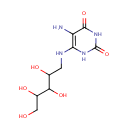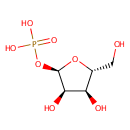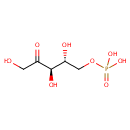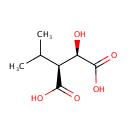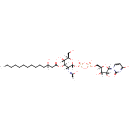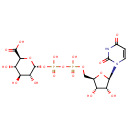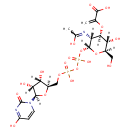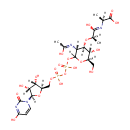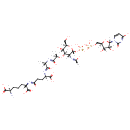
Search Results for compounds
Searching compounds for
returned 4373 results.
5-Amino-6-ribitylamino uracil (PAMDB000635)
IUPAC:
5-amino-6-[(2,3,4,5-tetrahydroxypentyl)amino]-1,2,3,4-tetrahydropyrimidine-2,4-dione
CAS: Not Available
Description: 5-Amino-6-ribitylamino uracil is an intermediate in riboflavin metabolism. It is converted from 5-Amino-6-(5'-phosphoribitylamino)uracil via dephosphorylation by the enzyme phosphohistidine phosphatase 1 (EC 3.1.3.-). (HMDB, KEGG)
Ribose-1-phosphate (PAMDB000637)
IUPAC:
{[(2R,3R,4S,5R)-3,4-dihydroxy-5-(hydroxymethyl)oxolan-2-yl]oxy}phosphonic acid
CAS: 14075-00-4
Description: Ribose 1-phosphate is an intermediate in the metabolism of Pyrimidine and the metabolism of Nicotinate and nicotinamide. It is a substrate for Uridine phosphorylase 2, Phosphoglucomutase, Purine nucleoside phosphorylase and Uridine phosphorylase 1. Ribose 1-phosphate can be formed from guanosine through the action of purine nucleoside phosphorylase. Ribose 1-phosphate can also act as a ribose donor in the synthesis of xanthosine as catalyzed by the same enzyme (purine nucleoside phosphorylase). The presence of guanase, which irreversibly converts guanine to xanthine, affects the overall process of guanosine transformation. The activated ribose moiety in Ribose 1-phosphate which stems from the catabolism of purine nucleosides can be transferred to uracil and, in the presence of ATP, used for the synthesis of pyrimidine nucleotides; therefore, purine nucleosides can act as ribose donors for the salvage of pyrimidine bases.
D-Ribulose 5-phosphate (PAMDB000638)
IUPAC:
{[(2R,3R)-2,3,5-trihydroxy-4-oxopentyl]oxy}phosphonic acid
CAS: 4151-19-3
Description: D-Ribulose 5-phosphate is a metabolite in the Pentose phosphate pathway. It is also involved in pentose and glucuronate interconversions, and in Riboflavin metabolism (KEGG)
3-Isopropylmalate (PAMDB000641)
IUPAC:
(2R,3S)-2-hydroxy-3-(propan-2-yl)butanedioic acid
CAS: 921-28-8
Description: 3-Isopropylmalate is an intermediate in valine, leucine and isoleucine biosynthesis. It is a substrate for 3-isopropylmalate dehydrogenase (TT_C0867)
UDP-3-O-(3-Hydroxymyristoyl)-N-acetylglucosamine (PAMDB000644)
IUPAC:
N-[(2R,3R,4R,5S,6R)-2-({[({[(2R,3S,4R,5R)-3,4-dihydroxy-5-(4-hydroxy-2-oxo-1,2-dihydropyrimidin-1-yl)oxolan-2-yl]methoxy}(hydroxy)phosphoryl)oxy](hydroxy)phosphoryl}oxy)-5-hydroxy-6-(hydroxymethyl)-4-{[(3R)-3-hydroxytetradecanoyl]oxy}oxan-3-yl]ethanimidic acid
CAS: 108636-29-9
Description: UDP-3-o-(3-hydroxymyristoyl)-n-acetylglucosamine is a member of the chemical class known as Pyrimidine Nucleotide Sugars. These are pyrimidine nucleotides bound to a saccharide derivative through the terminal phosphate group.
Uridine diphosphate glucuronic acid (PAMDB000646)
IUPAC:
(2S,3S,4S,5R,6R)-6-({[({[(2R,3S,4R,5R)-5-(2,4-dioxo-1,2,3,4-tetrahydropyrimidin-1-yl)-3,4-dihydroxyoxolan-2-yl]methoxy}(hydroxy)phosphoryl)oxy](hydroxy)phosphoryl}oxy)-3,4,5-trihydroxyoxane-2-carboxylic acid
CAS: 2616-64-0
Description: Uridine diphosphate glucuronic acid is a nucleoside diphosphate sugar which serves as a source of glucuronic acid for polysaccharide biosynthesis. It may also be epimerized to UDP Iduronic acid, which donates Iduronic acid to polysaccharides. It is made from UDP-glucose by UDP-glucose 6-dehydrogenase (EC 1.1.1.22) using NAD+ as a cofactor. It is the source of the glucuronosyl group in glucuronosyltransferase reactions. (Wikipedia)
UDP-N-Acetyl-3-(1-carboxyvinyl)-D-glucosamine (PAMDB000647)
IUPAC:
2-{[(2R,3R,4R,5S,6R)-2-({[({[(2R,3S,4R,5R)-3,4-dihydroxy-5-(4-hydroxy-2-oxo-1,2-dihydropyrimidin-1-yl)oxolan-2-yl]methoxy}(hydroxy)phosphoryl)oxy](hydroxy)phosphoryl}oxy)-5-hydroxy-3-[(1-hydroxyethylidene)amino]-6-(hydroxymethyl)oxan-4-yl]oxy}prop-2-enoic acid
CAS: 70222-94-5
Description: UDP-n-acetyl-3-(1-carboxyvinyl)-D-glucosamine is a member of the chemical class known as Pyrimidine Nucleotide Sugars. These are pyrimidine nucleotides bound to a saccharide derivative through the terminal phosphate group.
UDP-N-Acetylmuramoyl-L-alanine (PAMDB000648)
IUPAC:
(2S)-2-{[(2R)-2-{[(3R,4R,5S,6R)-2-({[({[(2R,3S,4R,5R)-3,4-dihydroxy-5-(4-hydroxy-2-oxo-1,2-dihydropyrimidin-1-yl)oxolan-2-yl]methoxy}(hydroxy)phosphoryl)oxy](hydroxy)phosphoryl}oxy)-5-hydroxy-3-[(1-hydroxyethylidene)amino]-6-(hydroxymethyl)oxan-4-yl]oxy}-1-hydroxypropylidene]amino}propanoic acid
CAS: 78738-65-5
Description: Udp-n-acetylmuramoyl-l-alanine belongs to the class of Pyrimidine Nucleotide Sugars. These are pyrimidine nucleotides bound to a saccharide derivative through the terminal phosphate group. (inferred from compound structure)UDP-N-acetylmuramoyl-L-alanine (UDP-MurNAc-L-Ala), which is the nucleotide substrate of the D-glutamic-acid-adding enzyme (the murD gene product) catalyzing the subsequent step in the pathway for peptidoglycan synthesis, appears to be an effector of the racemase activity. (PMID 8098327) MurD (UDP-N-acetylmuramoyl-L-alanine:D-glutamate ligase) is the second enzyme in the series of Mur ligases, and it catalyzes the addition of D-glutamic acid (D-Glu) to the cytoplasmic intermediate UDP-N-acetylmuramoyl-L-alanine (UMA). (PMID 19007109)
UDP-N-Acetylmuramoyl-L-alanyl-D-glutamate (PAMDB000649)
IUPAC:
(2R)-2-({2-[(2-{[(3R,4R,5S,6R)-2-({[({[(2R,3S,4R,5R)-3,4-dihydroxy-5-(4-hydroxy-2-oxo-1,2-dihydropyrimidin-1-yl)oxolan-2-yl]methoxy}(hydroxy)phosphoryl)oxy](hydroxy)phosphoryl}oxy)-5-hydroxy-3-[(1-hydroxyethylidene)amino]-6-(hydroxymethyl)oxan-4-yl]oxy}-1-hydroxypropylidene)amino]-1-hydroxypropylidene}amino)pentanedioic acid
CAS: 17088-64-1
Description: UDP-n-acetylmuramoyl-L-alanyl-D-glutamate is a member of the chemical class known as Peptides. These are compounds containing an amide derived from two or more amino carboxylic acid molecules (the same or different) by formation of a covalent bond from the carbonyl carbon of one to the nitrogen atom of another. UDP-N-acetylmuramoyl-L-alanyl-D-glutamate is a key component of peptidoglycan synthesis. The peptidoglycan synthesis pathway starts at the cytoplasm, where in six steps the peptidoglycan precursor a UDP-N-acetylmuramoyl-pentapeptide is synthesized. This precursor is then attached to the memberane acceptor all-trans-undecaprenyl phosphate, generating a N-acetylmuramoyl-pentapeptide-diphosphoundecaprenol, also known as lipid I. Another transferase then adds UDP-N-acetyl-alpha-D-glucosamine, yielding the complete monomeric unit a lipid , also known as lipid . This final lipid intermediate is transferred through the membrane. The peptidoglycan monomers are then polymerized on the outside surface by glycosyltransferases, which form the linear glycan chains, and transpeptidases, which catalyze the formation of peptide crosslinks. UDP-N-acetylmuramoyl-L-alanyl-D-glutamate:meso-diaminopimelate ligase is a cytoplasmic enzyme that catalyzes the addition of meso-diaminopimelic acid to nucleotide precursor UDP-N-acetylmuramoyl-L-alanyl-D-glutamate in the biosynthesis of bacterial cell-wall peptidoglycan. (PMID 11124264)
UDP-N-Acetylmuramoyl-L-alanyl-D-glutamyl-meso-2,6-diaminoheptanedioate (PAMDB000650)
IUPAC:
(4R)-N-[(1S,5R)-5-amino-1,5-dicarboxypentyl]-4-carboxy-4-{[(2S)-2-{[(2R)-2-{[(2R,3R,4R,5S,6R)-2-({[({[(2R,3S,4R,5R)-3,4-dihydroxy-5-(4-oxido-2-oxo-1,2-dihydropyrimidin-1-yl)oxolan-2-yl]methoxy}(hydroxy)phosphoryl)oxy](hydroxy)phosphoryl}oxy)-5-hydroxy-6-(hydroxymethyl)-3-[(1-oxidoethylidene)amino]oxan-4-yl]oxy}-1-hydroxypropylidene]amino}-1-oxidopropylidene]amino}butanecarboximidate
CAS: Not Available
Description: UDP-n-acetylmuramoyl-L-alanyl-D-glutamyl-meso-2,6-diaminoheptanedioate is a member of the chemical class known as Peptides. These are compounds containing an amide derived from two or more amino carboxylic acid molecules (the same or different) by formation of a covalent bond from the carbonyl carbon of one to the nitrogen atom of another. It is a key component of peptidoglycan synthesis. The peptidoglycan synthesis pathway starts at the cytoplasm, where in six steps the peptidoglycan precursor a UDP-N-acetylmuramoyl-pentapeptide is synthesized. This precursor is then attached to the memberane acceptor all-trans-undecaprenyl phosphate, generating a N-acetylmuramoyl-pentapeptide-diphosphoundecaprenol, also known as lipid I. Another transferase then adds UDP-N-acetyl-alpha-D-glucosamine, yielding the complete monomeric unit a lipid , also known as lipid . This final lipid intermediate is transferred through the membrane. The peptidoglycan monomers are then polymerized on the outside surface by glycosyltransferases, which form the linear glycan chains, and transpeptidases, which catalyze the formation of peptide crosslinks.
